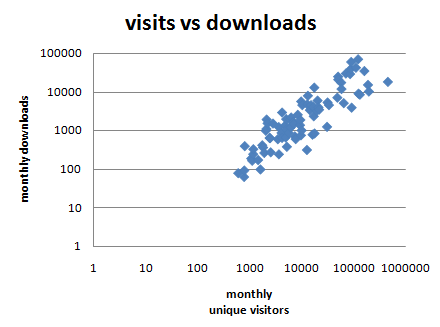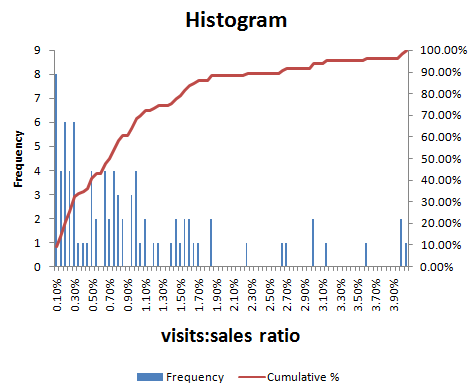 Overview
Overview
An anonymous survey of software vendors shows that the average sale to visit ratio is very close to the much quoted “industry average” of 1%. However the data shows large variations between products and across different sectors (e.g. Windows vs Mac OS X).
The data
The data set comprises 92 valid survey responses to an 8 question survey in April 2009. The survey was advertised through a request on this blog, posts on BOS, ASP, MACSB, OISV and BOSnetwork forums and emails to the author’s contacts. The results are inevitably biased towards small software vendors, due to the places where the survey was advertised. As the survey was anonymous it is impossible to verify the accuracy of the data. However it is unlikely that many vendors would have completed a survey that wasn’t anonymous.
The survey consisted of 3 compulsory questions (unique visits, downloads and sales over a given timeframe) and 5 optional questions (the time frame of the data, primary market, primary OS, licence price and trial type). One record had 0 visits (an iPod app), another had 0 downloads (presumably a web app) and a few had numbers that I didn’t consider statistically valid for some purposes (e.g. <500 visits per month or <3 sales transactions per month). I did the best I could with the data available, ignoring obvious outliers in some cases.
The data set comprises a total of:
- 8.1 million unique website visits
- 2.2 million downloads
- 110 thousand sales transactions
Where a time frame for the results was given it is possible to work out the range of visitors, downloads and sales per month.
Interestingly the distribution of monthly visits, downloads and sales across the different products all follow the Pareto 80:20 power law quite closely:
- 22% of the products account for 80% of the visits
- 21% of the products account for 80% of the downloads
- 19% of the products account for 80% of the sales
This gives me some faith that the data is reasonably accurate and representative of the industry as a whole.
The data is broken down by OS, market, price and trial type as follows:
Analysis
The average (mean) ratio of downloads:visits across all products is 28%. 50% of products are in the range 12.1% to 35.3%.
I am surprised at how high the average ratio is. This could partly be due to products that receive a high percentage of downloads from download sites, without the downloader ever visiting the product site. Conversely sites where visitors make frequent returns after purchase (e.g. to read forums) will have a lower downloads:visits ratio.
The average ratio of sales:downloads across all products is 4.5%. 50% of products are in the range 1.3% to 6.4%.
The average sales:downloads ratio is noticeably lower than the average downloads:visits ratio. The sales:downloads ratio is noticeably skewed on the right of the graph – a sales:downloads ratio >20% seems very high.
The (logarithmic) scatter plots below show that the downloads:sales ratio varies a lot more than visits:downloads ratio.
 The average (mean) sales:visits ratio of all products is 1.16%[1]. However one of the product ratios is an obvious outlier at 13.94% (see below). With this outlier removed the average sales:visits conversion ratio across all the products is 0.99%. 50% of products are in the range 0.28% to 1.39%.
The average (mean) sales:visits ratio of all products is 1.16%[1]. However one of the product ratios is an obvious outlier at 13.94% (see below). With this outlier removed the average sales:visits conversion ratio across all the products is 0.99%. 50% of products are in the range 0.28% to 1.39%.
0.99% is suspiciously close to the mythical ‘industry average’ of 1%. But I haven’t (consciously) massaged the results to get this figure.
You can work out how you compare to this data set using the red (cumulative) graph in the histogram below. For example, if your product sales:visits ratio is 1.5%, then it is higher than approximately 80% of the products in the data set.
We can also look at how the ratios vary across sectors. Surprisingly the average Mac product conversion ratio is more than 4 times the Windows product conversion ratio.
 Even if we try to compare like for like, and only compare consumer products selling for <= $50, the ratios are still 2.27% for Mac and 0.51% for Windows. Possible reasons for this large disparity include:
Even if we try to compare like for like, and only compare consumer products selling for <= $50, the ratios are still 2.27% for Mac and 0.51% for Windows. Possible reasons for this large disparity include:
- Mac owners more ready to spend money.
- There is less competition in the Mac software market.
- Mac vendors have a higher percentage of purchasers who never visit their site due to higher quality of Mac download sites.
- It is a statistical blip (there are a lot less Mac products in the survey).
My own experience with selling a cross-platform product (Perfect Table Plan) on Windows and Mac OS X is that the Mac sales:visits ratio is approximately double that for Windows.
The sales:visits ratio is similar for business and consumer products, with developer products lagging behind. However there are too few developer products in the data set to draw any real conclusions.
 The sales:visits ratio does vary across the price range. However there are too few products with price >$50 in the data set to draw any real conclusions.
The sales:visits ratio does vary across the price range. However there are too few products with price >$50 in the data set to draw any real conclusions.
 The sales:visits ratio does not seem to vary significantly by trial type. There were insufficient ‘number of use’ trial products to include them.
The sales:visits ratio does not seem to vary significantly by trial type. There were insufficient ‘number of use’ trial products to include them.
Conclusion
One has to be careful about drawing conclusions from a relatively small and unverifiable data set. However the results certainly seem to support the much-quoted “industry standard” sales:visits conversion ratio of 1%. But there are huge variations between products.
The fact that the sales:downloads ratio is both lower on average and more variable than the downloads:visitors ratio implies that getting people to download is the easy bit and converting the download to a sale is a tougher challenge.
The average sales:visits conversion ratio is noticeably higher for Mac OS X products than Windows products. This is supported by anecdotal evidence and the author’s own experience with a cross-platform product. However the number of Mac respondents to the survey is too small for the result to be stated with any great confidence. Also remember that the Mac market is still a lot smaller than the Windows market before you rush off to start learning Cocoa and Objective-C.
These ratios can be useful for a number of purposes, including: identifying a bottleneck in your conversion funnel (is your downloads:visitors ratio low compared to other products?); estimating how much traffic you might need for a viable business; or estimating how much you can afford to bid on Google Adwords. And it is useful to track how these ratios change over time (I track mine on a monthly basis). But make sure you compare like with like if you are comparing your ratios with other products. For example, a 10% sales:downloads ratio might be achievable for a niche business product, but unrealistic for a casual game. And remember that these ratios are only one part of a bigger picture. There are other, more important, metrics. Profitability for a start.
The data set is available here:
Raw data (some invalid records deleted), CSV format
Processed data, Excel XLSX format
Feel free to publish your own analysis. Thank you to everyone that took part in the survey.
[1] Calculating the mean of all the ratios probably isn’t the way a proper statistician would do it. But anything more seems overkill given the limited size and unverifiable nature of the data set.














Can you give the median as well?
Really interesting analysis. I do some benchmarking work on the side so I can appreciate this info. I would guess that the process of correlating “downloads” with sales is not as big a factor as it once was, and not improving in the indutsry as a whole. One reason may be that in the software world as a whole, more software is sold online, via outside affiliates, and driven more by SEO and marketing factors today, than desktop applications and PC shareware solutions. Also, as in my case, I don’t deliver a trial, as I sell website photo software and scripts directly, which are demo’ed online. For that reason, I measure sales in terms of how well the site and SEO is doing. That also is affected by the software improvements. So, I cannot say, downloads is a factor for my. I do have a freeware version, but its not a sales tool, but a marketing tool and brand awareness issue for me. I only measure its affectiveness in terms of vistors who come to the site from the freeware, which isnt a big factor (ie < 1%), as it should be. Its not a sales tool, but a marketing tool.
What I would guess is sales to site visits is a better metric, using weighted averages, and combined with Google Analytics factors, like bounce rates, goals, and time on site, could show and predict how often people buy a product from you. Downloads becomes yet another “key factor” in that formula, but not a benchmark metric.
Also, saying you can expect 1% of sales is like saying, “it’s all a numbers game” and if I can increase traffic or downloads, I will sell more. We all know thats true, in a general sense, but the data shows that its increasingly hard to do, and only the top 10% get over 2%. Therefore, downloads isnt a solid factor for improving sales. I think driving the “quality” of visits is a much better goal, if we could measure that. For example, users who visit a purchase page. That could include download people, non-download people, marketing campaign vistors, new visitors, returning, etc. I would much rather have 5% sales from fewer people measured from all metrics, than 1% from one static group of customers that rarely fluctuates, simply because I know now all my software and marketing efforts are working better, and can have a radical impact on sales, regardless of visits and downloads. I guess I am getting into SEO here, but you get the picture.
Anyway, interesting results!
Matt,
From the histogram the media sales:visits ratio is 0.7%
Andy
What a fabulous post. I’m a newbie Mac application developer and I’ve been struggling to work out how many unique visitors I need to pay my bills. Now I can base my predictions on hard data. This is really valuable information. Well done.
Thanks again for all your hard work in getting us these really useful statistics.
John Gallagher
Andy,
It’s fantastic to see some real data on this issues. Very nice work, the post is of excellent quality.
Thanks
Andy….Thanks for this thorough and insightful post.
Thanks for taking the time, effort and interest to put this together and making it available.
Thank you.
Pingback: Lifestyle business » Blog Archive » Вся правда о conversion rate для скачиваемого софта
Pingback: The FastSpring E-Commerce Blog » Blog Archive » What Is A Typical Visit To Sale Ratio For Software Vendors?
brillant stats
It would be great to see…
webapp – php vs .net and sales figures
desktop app – delphi, mfc , wpf, clickonce, winforms, vb 6.0
to see what desktop technologies are more likely to make it over another to see why the technology doesn’t make it from a trial to a paying customer
Red Gate is looking for products with a 10% download to sale conversion ratio: http://blog.businessofsoftware.org/2009/04/the-red-gate-million-dollar-challenge.html
Looks like only 1 product in the roundup would satisfy that. Any ideas why? Is Red Gate just way over the top in that requirement? Or are most of the products in the roundup optimized for conversions? I’m getting ~0.5% download to conversion, so 10% seems way high to me.
Pingback: Weekly linkdump #174 - max - блог разработчиков
Pingback: Show #25: Andy Brice and PerfectTablePlan. « The Startup Success Podcast
Pingback: 47 Hats - The MicroISV Digest
Very interesting post. I have been working out my own numbers for my company, and I must say that our past two years of data look quite a bit better than your averages, but we are in a small niche market. It actually validated several of my metrics though, so thanks for sharing that information.
Pingback: Convert more Software Trials to Purchases | Avangate Blog - Software Business Blog
Very informative read. Thanks for putting it together. , Astute readers, however, will recognize software distribution as being from Extremistan (ref Nassim Nicholad Taleb’s “The Black Swan”), e.g. is not a Gaussian distribution. For such populations, your admitted practice of “ignoring obvious outliers” can be dangerous. :-)
I have read “The black swan”. Very interesting, although Taleb’s ego did get in the way a bit.
The fact that one vendor has nearly 3 times the sales:downloads of the next highest is rather suspicious. It might be because the data was inaccurate (e.g. a missing 0) or that vendor used a different way of measuring the results to everyone else. In which case ignoring it is valid.
In any case, I might have been better looking at the median conversion rate, rather than the mean, as the median is less sensitive to outliers.
Pingback: tekBlues » Blog Archive » Great resources for uISVs
Pingback: Кто первый встал того и тапки | begemotov.net
Pingback: Five tested ways to convert more software trials to purchases « widaca
Pingback: Chuck Brooks For FutureWare » Blog Archive » The Elastic Measure Of Success
Pingback: Why Hammers Sell Better Than Your Software | Avangate Blog - Software Business Blog
Pingback: Are software companies overlooking a valuable strategy for increasing conversions? «
Pingback: Why I’m Done Making Desktop Applications: MicroISV on a Shoestring
This is great. I am currently trying to work out conversion rates for our yet-to-go-live ISV for our cash flow projections.
We were wondering if business software had a higher than industry standard conversion rate because its not a tire kicking type search.
Still, the variables remain great even if I knew the answer … Really it comes down to:
have you created some software that people want and then, its about communicating that to your intended audience. All easier said than done.
Pingback: 5 great ways to waste money in Google Adwords « Successful Software
Thank you very much for this brilliant post! Great work…
I can now estimate the needed traffic on my site and budget a Google Adwords campaign.
It would also be interesting to have the data available regarding different kind of products (games, business, engineering, web, etc.).
Thanks again!
Pingback: First impressions count « Successful Software
Superb post, thanks. I wish I’d read this when you first wrote it. I’ve been trying to work out why my conversion ratio is low – turns out it’s not, basically.
Pingback: Advertising your software on Facebook (=Fail) « Successful Software
Nice article but a real shame the data have such coarsely rounded product prices because that introduces unbounded errors in any calculation involving the single most important quantity: money.
From my own calculations of our own product sales, our monthly revenue from a product is proportional to its unit cost. The more we charge, the more profit we make.
Most of us require a lot more this sort of site owners just like you on the web and also a lot fewer spammers.